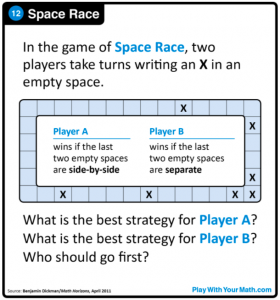I have finally made it to real time and cleared most of my bookmarks from the last year. Here are my favourites from August 2021.
Susan Carriker shared links to geometry tasks and activities, again sorted by concept.
A Google Sheet with links out to Geometry Resources: Desmos, Geogebra, Mathigon, etc.. I have JUST started (only 3 weeks are done) If you have something amazing I need to include, please reply with the link! #iteachmath #mtbos #mathschat #edtech https://t.co/I3dRKI86YI
— S Carriker (@s_carriker) August 1, 2021
Transum tweeted that the Boxed in Fractions game can now be played independently.
You can now play the Boxed-In Fractions game against the computer if there isn’t a “someone else” nearby willing to challenge you.https://t.co/VIukdDKECk
Thanks for the suggestion @ColleenYoung#mathsresources #mathschat #mathchat #Mathsgame #edutwitter pic.twitter.com/wt69hWjOUP
— Transum (@Transum) August 5, 2021
Richard Perring shared an article that includes Tokyo Olympics statistics. I am thinking about how I could use these leading up to the Beijing Olympics.
Tokyo Olympics: All the best stats from the 2020 Games – BBC Sport https://t.co/5W5rpm74rO
— Richard Perring (@LearningMaths) August 9, 2021
Anne Agostinelli shared a Google Doc with “resources to spark mathematical discussions”. I already have most of these links bookmarked, but there are few new ones for me to add to the repertoire.
'Tis the season to share this doc with awesome resources for math/number talk planning!#iteachmath #mtbos #numbertalkhttps://t.co/1rc3LZMKnV
— Anne Agostinelli (@anneagost) August 11, 2021
Howie Hua made a Google Doc adaptation of the Got It! Game.
I highly recommend playing "Got it!" created by @TomJolly19 as it's often a favorite in our courses. You have a target number and you create number sentences by using connected cards. I made an online adaptation here:https://t.co/Z7hBkvjbYW pic.twitter.com/es4E894FVH
— Howie Hua (@howie_hua) August 12, 2021
Sarah Carter tweeted about the Crazy Eights puzzle. I just tried it and got 1-6 easily. It took a few more minutes to get 8, but I will need a little more time for 7!
Crazy Eights Puzzle never gets old! I love that this activity is actually eight challenges in one. https://t.co/DHcoECWsDw#mtbos #iteachmath #teach180 pic.twitter.com/aNcXXN9iVA
— Sarah Carter (@mathequalslove) August 16, 2021
She also shared this Fitting Shapes puzzle.
Fitting Shapes Puzzle https://t.co/tjXYbyAK0X #mtbos #iteachmath #puzzlingclassroom pic.twitter.com/KzBCYUMl93
— Sarah Carter (@mathequalslove) August 21, 2021
Eda Aydemir shared a Bingo game on Polypad.
Let's play Bingo with Polypad.
The Caller's Polypad: https://t.co/wW5dDPg7eA
Player Polypads: https://t.co/fEwhbBgMxZ. Change dice to change the sample space, and create your own Bingo Card to max your chance! @MathigonOrg #MTBoS #iteachmath pic.twitter.com/9OK3qGhETz— Eda Aydemir (@edaydemir) August 18, 2021
Nate Madick has organized activities from Brilliant by concept.
https://twitter.com/MadickNate/status/1425196653972135938
Jo Morgan has another blog post full of gems.
https://twitter.com/mathsjem/status/1429360992895520772
This is a good addition to my list of NRICH interactive games. What is the least number of reveals required to solve the board? Also check out the follow up game.
Monday's puzzle is Missing Multipliers – how many 'reveals' will you need before you can complete the grid? https://t.co/OYfPJB0RoG @FacultyMaths @CamEdFac @Cambridge_Uni
— NRICH maths (@nrichmaths) August 23, 2021
Our Tuesday challenge for secondary students is Finding Factors – find the hidden factors which multiply together to produce each quadratic expression https://t.co/bAswu2Z1PU @FacultyMaths @CamEdFac @Cambridge_Uni
— NRICH maths (@nrichmaths) August 24, 2021
And Jason Murphy put one of the many NRICH puzzles on Polypad.
I turned the @nrich factors and multiples puzzle into an interactive @mathigon polypad.
Original: https://t.co/KroDhesnJE
Polypad: https://t.co/Zas0PUtlGF pic.twitter.com/U8GIrUBehw
— Jason Murphy (@MathsTweetcher) August 27, 2021
Professor Smudge posed this challenge:
The grid-lines are 1 cm apart.
Without using Pythagoras' Rule, find the length of AB. pic.twitter.com/qdpi2u5T3s— Professor Smudge (@ProfSmudge) August 23, 2021
And for some science….
I like this version of the Periodic Table that shows the history of discovery of each element.
This is an interesting take on the Periodic Table, showing the history of discovery of each element pic.twitter.com/sprg6cHWxw
— Hookean (@Hookean1) August 15, 2021
Nikki Wilkinson shared a digital Physical and Chemical Changes lab.
If you need a way to safely do a stations lab, try this physical and chemical changes activity! #chemistry #physicalscience https://t.co/mv4lvJIWRb pic.twitter.com/AeAEg16eun
— Nikki Wilkinson (@Wilkinson_STEM) August 12, 2021
Bethany Saunders shared her States of Matter handout that she uses with one of the PhET Sims.
— Bethany Saunders (@bhsaunders) August 24, 2021
That is all for now. Have a great week!





